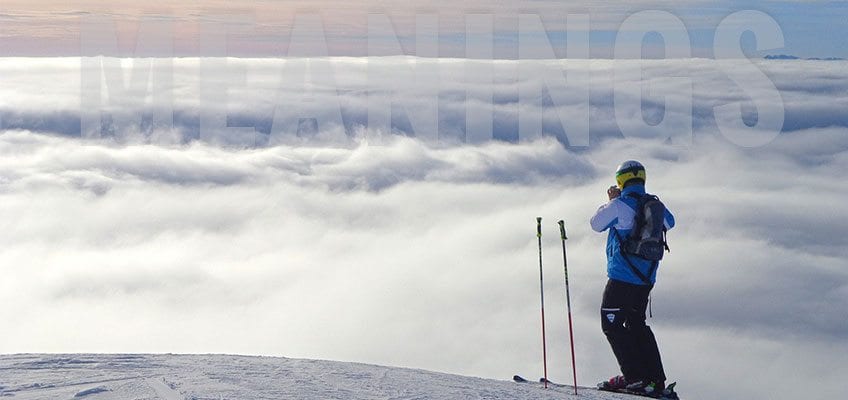Everything You Need To Know About Skiing

Attribution: Title: Skiing | Author: Lena 1 | Licence: CC0 Public Domain
Have you heard the skiing terms whilst out on the slopes but not sure what they mean? Then read on for an explanation
Skiing Category
Alpine skiing is the most common type of skiing which includes a stiff boot being secured to a ski and involves skiing down mountains.
Telemark skiing is where the boot is only attached at the toe and the heel is free. Telemark skiers sometimes walk up the mountains in their skis before skiing down the mountain.
Cross country skiing involves the use of lighter shoes and narrower skis and is also open at the heel. This type of skiing takes place on flatter trails.
Piste, Slope and Trail
Pistes are marked and patrolled snow routes where the snow is compacted and flattened by snow machines to avoid skiers and snowboarders from sinking. They are generally graded to serve as a guide to their difficulty and steepness. The type of graded pistes are:
- Nursery slopes – Beginners.
- Green – Very easy and gentle slope.
- Blue – Easy slope and not deep.
- Red – Intermediate.
- Black – Advanced slope.
- Ski route – Marked and patrolled off piste route.
Off-Piste refers to un-groomed parts of a mountain. Since it is not mark and groomed skiers will sink and it is considered to be high risk due to rocks and avalanches.
Lift Pass
It is a ticket that allows you to access the lifts in a ski area. The pass is like a credit card which you can easily store in a pocket.
Après-Ski
This means ‘after skiing’ in French and is a general terms used for forms of entertainment engaged in by the skiers after a day on the snow. This can include social events, nightclubbing or dining events with all occurring specifically at ski resorts. The purpose of these events is to provide downtime and alternative entertainment to visitors at ski resorts.
Packed Powder and Powder
Packed powder is when snow has been compressed down to prevent skiers from sinking. Whereas, powder is when the natural snow is left uncompressed and is meant for snowboarders.
Slush
It is snow that is melting and formed out of ice crystals. It often happens in areas that are busy with skiers and places which seem to attract maximum sun towards the end of the day. Skiers feel like skiing on wet concrete in slush areas.
Ice
Pistes become solid and icy when it has not snowed for a while. This makes it difficult to push the skis into the snow and reduces skier’s control.
Avalanches
There are different types and sizes of an avalanche which are usually triggered by skiers and snowboarders or starts naturally. It occurs in areas where an unstable layer of natural snow breaks away and travels down a slope.
Moguls and Bumps
These are lumps of snow that has piled up as a result of a lot of a skiers turning in the same place.
Skis, Snowboards, Boots, Bindings and Poles
All essential equipment required for skiing. You have the choice of buying or renting from the resorts on your visit. Another option is to borrow from people you know though they may not be the same size as you.
Helmet
This is one of the most important pieces of ski gear in case of falls and collisions. Wearing a helmet is compulsory for children.
Skiing Pants, Jacket, Thermals and Fleece
Skiing pants and jackets are waterproof to prevent water from getting into the clothes that skiers wear inside which includes thermal and fleece. Thermals are base layer which are warm and ideal active clothing whereas a fleece is worn over the base layer. The thickness of the fleece will depend on how cold it is.
Gloves, Goggles, Scarf, Storm Mask and Buff
Waterproof gloves are essential for protecting the hands and providing grip and protection for the wrist. Also essential to your kit are goggles as they help define the outlines of the slopes in poor visibility and protect the eyes from the harsh reflections of the sun.
Packing a scarf, storm mask and buff will help protect your face from the snow and any type of unforeseen weather conditions.
Ski Lessons
Almost all qualified instructors at resorts are English speakers and if you are interested in taking lessons then it is best to book ahead. If you are a beginner it is best to avoid taking lifts up to the mountains until you are confident.
Types of Lifts
Rope Lift
This type of lift requires skiers to hold onto a rope which moves and pulls them up a slope. Normally found on nursery slopes.
Magic Carpet
It is a carpet that skiers and boarders can stand on and get taken up a slope. It is also found on nursery slopes.
T-Bar
It is a T shape bar that hangs from an overhead cable which pulls skiers and boarders up a slope.
Button Lift
This type of lift has a button shape attachment that hangs from an overhead cable that pulls skiers and boarders up a slope.
Chair Lift
It is the most popular and favourite lift which takes skiers and boarders up the mountain in a chair whilst they rest their ski and boards on a bar.
Gondola
It is a cabin lift that can hold up to 8 people and is attached to a cable and taken up the mountain. Skiers can take off their skis and sit or stand when taken up the mountain. Many Gondolas can fit onto a cable.
Cable Car
Cable car is a larger cabin lift which can carry up to 40 people at a time but only one cabin can fit on a cable.
Leave a Reply
Want to join the discussion?Feel free to contribute!